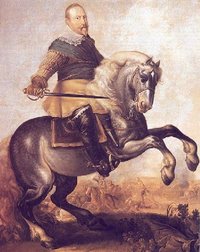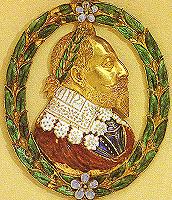Gustavus Adolphus of Sweden
|
|
 | |
| Reign | October 30, 1611 – November 6, 1632 O.S.
(Government from December, 1611) |
| Coronation | October 12, 1617 |
| Royal motto | "Cum Deo et victribus armis" ("With God and arms victorious") |
| Queen | Maria Eleonora of Brandenburg |
| Royal House | Vasa |
| Predecessor | Charles IX of Sweden |
| Successor | Christina of Sweden |
| Date of Birth | December 9, 1594 |
| Place of Birth | Stockholm |
| Date of Death | November 6, 1632 (Julian calendar) or November 16 (Gregorian calendar) |
| Place of Death | At the battle of Lützen, Germany |
| Date of Burial | June 22, 1634 |
| Place of Burial | Riddarholmskyrkan, Stockholm |
Gustav II Adolf (December 9, 1594 – November 6, 1632 O.S.) (widely known by the Latinized name Gustavus Adolphus and in Protestant propaganda as Lion of the North) was the king of Sweden. He was born in Stockholm, the son of Charles IX of the Vasa dynasty and Christina of Holstein-Gottorp.
He was the king of Sweden from 1611, and as such one of the major players in the Thirty Years' War where he was styled as "The Lion of the North—Savior of Protestants". Gustav Adolf was married to the daughter of the elector of Brandenburg-Prussia, Maria Eleonora and chose Prussia's city of Elbing as base for his operations in Germany. He died in battle on November 6, 1632 at Lützen in Germany.
During his reign, Gustav founded the city of Gothenburg as well as a number of smaller cities. He is also the founder of the University of Tartu in Tartu, Estonia, which then belonged to the kingdom of Sweden. In this time, the three largest cities in the kingdom were Riga (currently the capital of Latvia), Stockholm and Tallinn (capital of Estonia).

As a general, Gustav is famous for employing mobile artillery on the battlefield, as well as a very active tactic where attack was stressed over defense and mobility more important than in the usual linear tactic.
This was only part of the reason why Carl von Clausewitz and Napoleon Bonaparte idolized him as the general above all others. His character both of purpose and of amity with all his troops from commanding officers right down to the rank and file, earned him unassailably documented fame which most commanders in chief would gladly accept as mere joking anecdotes.
The king was an active participant in the battles, and was wounded several times, including gunshot wounds to the throat and the abdomen. His war wounds led the king to adopt a flexible armour of hide instead of the customary metal cuirass, and this is what he wore in the Battle of Lützen. Gustav's armour is currently on display in the Royal Swedish Armoury at the Royal Palace in Stockholm.
Gustav used the name Captain Gars to travel Europe incognito. Gars is derived from the initials of "Gustavus Adolphus Rex Sueciae", Latin for "Gustav Adolf King of Sweden".
Gustav was killed in the renowned Battle of Lützen where he was misled by dense fog and poor eyesight to charge into an enemy formation. After his death, his wife Maria Eleonora of Brandenburg initially kept his body, and later his heart, in her castle for over one year. His remains (including his heart) now rest in Riddarholmskyrkan in Stockholm.
In February 1633, following the death of the great king, the Swedish Riksdag of the Estates decided that his name would be accompanied by an accolade and that his name was to be styled Gustav Adolph the Great (or Gustav Adolf den Store in Swedish). Such an honor has not been bestowed on anyone else since.
The crown of Sweden was inherited in the family of Vasa, and from Charles IX's time excluded those Vasa princes who had been traitors or descended from deposed monarchs. Gustav Adolph's younger brother had died years ago, and therefore there were only females left. Maria Eleonora and the king's ministers took over the government on behalf of Gustav Adolph's underage daughter Christina of Sweden upon her father's death. He left two children of wich we are aware: his illegitimate son Gustav, Count of Vasaborg, and his legitimate daughter queen Christina of Sweden
Timeline
- May 1630. Gustav lands with his army in Pomerania. On July 6 he lands in Germany.
- September 1631. At the Battle of Breitenfeld, Gustav decisively defeats the catholic forces led by Tilly, even after the allied protestant Saxon army was routed and fled with the baggage train.
- March 1632. At the Battle of Lech, Gustav defeats Tilly once more, and in the battle Tilly sustains a fatal wound.
- April 1632. Battle of Rain.
- May 1632. Munich yields to the Swedish army.
- September 1632. Gustav attacks the stronghold of Alte Feste, which is under the command of Wallenstein, but is repulsed. This leads to defection of some mercenary elements in the protestant army.
- November 1632. The Battle of Lützen, Gustav is killed but the Swedes win the day and defeat Wallenstein. The Swedish war effort was kept up by generals Horn, Banér, Torstensson and chancellor Oxenstierna until the Peace of Westphalia.
A history of Adolphus' wars was written by Johann Philipp Abelin.
The Day of Gustav Adolph is revered each year on November 6 in Sweden. On this day a special pastry, with a chocolate medallion of the king, is sold. The day is also an official flag day in the Swedish calendar.
Fictional appearances
Gustavus Adolphus plays an important supporting role in Eric Flint's 1632 series of science fiction/alternate history novels.
See also
- History of Sweden - Rise of Sweden as a Great Power
- Axel Oxenstierna
- Gustav Gustavsson af Vasaborg
- Gustavus Adolphus College
| Preceded by: Charles IX | King of Sweden 1611-1632 | Succeeded by: Christina |
de:Gustav II. Adolf von Schweden et:Gustav II Adolf fr:Gustave II Adolphe de Suède nl:Gustaaf II Adolf ja:グスタフ・アドルフ no:Gustav II Adolf av Sverige pl:Gustaw II Adolf pt:Gustavo Adolfo ru:Густав II Адольф fi:Kustaa II Aadolf sv:Gustav II Adolf


